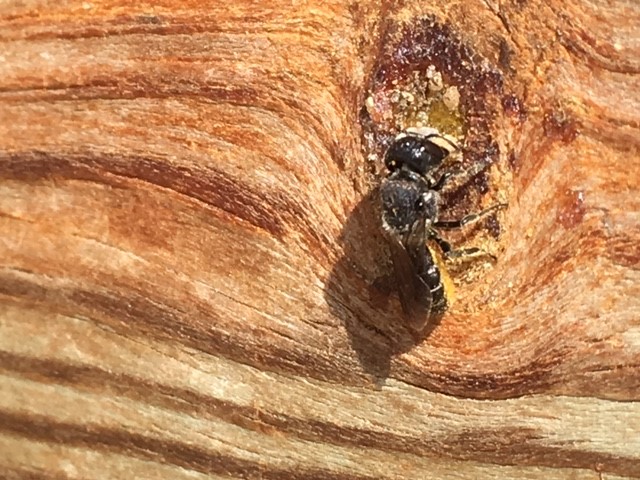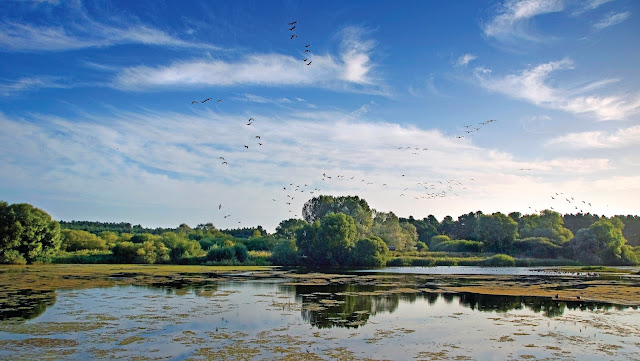With a site so diverse and as large as Lackford Lakes, there is always something new to find, we just have to look for it. This is especially true when it comes to the small stuff such as insects, spiders and other bugs. All to often we are taken with the beauty of a Red Admiral as it basks on a leaf, or a big fluffy bumblebee as it bounces from flower to flower. We look on in awe as large dragonflies patrol the pathways grabbing flies in mid-air and consuming them without stopping. However, occasionally something else pops up as an oddball. Something that has caught the eye of a visitor, something they haven't seen before, a fly, a bee, a cricket or a spider. Often they return to the visitor centre to ask staff to help with the ID of their new discovery. Sometimes what they have seen is actually quite a common species, but every now and then something special turns up.
This is just what happened to regular visitor and keen photographer Sarah West who saw what she thought was a wasp sitting on a leaf.
On showing it to me, I spotted straight away it wasn't a wasp, but a fly, a Conops. It turned out to be a the rarest of Conops flies called Conops vesicularis (unfortunately no common name) and was only the 3rd time it had ever been recorded in Suffolk! This fly parasitises hornets and some bees hence its very fooling mimicry which allows it to get close to its victims.
Early last year I asked local spider expert Alan Thornhill if he would be interested in surveying Lackford Lakes for spiders. He said he was very interested and got to work straight away setting up pitfall traps in various locations around the reserve and it was so successful, he carried on surveying right through till autumn 2017. Along the way he found some interesting spiders with varying degrees of rarity and then he found something rather special. It was special because it had never been found in Suffolk before AND it is in serious decline through loss of habitat. The spider has the name of Haplodrassus silvestris and again has no common name. It has probably been living at Lackford since it became a reserve and it's a credit to the hard work of the Trust and its volunteers that create the habitat that it still exists at Lackford today.
I myself am often seen out on the reserve when I get the chance, looking for my specialty, bees and wasps. Over the last few years, I too have made some discoveries at Lackford including another first for Suffolk this year in the shape of the Early Mining Bee, a species usually found in sand dunes in the west and north west of the country, and here it is for the first time in Suffolk and again listed as rare. When I first started working here at Lackford 3 years ago, I found around 6 Large-headed Resin Bees nesting in a piece of old timber outside the centre. This was a rare bee and this was only the 7th record for Suffolk at the time.
I installed a solitary bee hotel and this year the bee is doing very well and can be found nesting in a variety of places around the reserve. This expansion in species in turn brought another rarity to the reserve in the form of a jewel wasp known as Chrysis gracillima, only recorded in Suffolk twice before.
Volunteer James Robinson managed to photograph this Silver-washed Fritillary whilst doing a dragonfly survey.
Now these butterflies are not particularly rare, more of a localised species. However, until James got this photo, this butterfly had never been recorded at Lackford ever before, so it's quite rare for here.
Now we have the opportunity to extend the nature reserve by another 77 acres of prime Breckland grassland habitat. This will not only provide nesting sites for birds such as Stone Curlew, but will also be home to a whole host of insects too. Who knows how many rarities may be living there?
Without doubt, it would seem that all around us there are things waiting to be discovered, we just need to take the time to look at the little things too.
By Hawk Honey - Visitor Officer
This is just what happened to regular visitor and keen photographer Sarah West who saw what she thought was a wasp sitting on a leaf.
 |
| An unusual wasp, or is it? © Sarah West |
Early last year I asked local spider expert Alan Thornhill if he would be interested in surveying Lackford Lakes for spiders. He said he was very interested and got to work straight away setting up pitfall traps in various locations around the reserve and it was so successful, he carried on surveying right through till autumn 2017. Along the way he found some interesting spiders with varying degrees of rarity and then he found something rather special. It was special because it had never been found in Suffolk before AND it is in serious decline through loss of habitat. The spider has the name of Haplodrassus silvestris and again has no common name. It has probably been living at Lackford since it became a reserve and it's a credit to the hard work of the Trust and its volunteers that create the habitat that it still exists at Lackford today.
I myself am often seen out on the reserve when I get the chance, looking for my specialty, bees and wasps. Over the last few years, I too have made some discoveries at Lackford including another first for Suffolk this year in the shape of the Early Mining Bee, a species usually found in sand dunes in the west and north west of the country, and here it is for the first time in Suffolk and again listed as rare. When I first started working here at Lackford 3 years ago, I found around 6 Large-headed Resin Bees nesting in a piece of old timber outside the centre. This was a rare bee and this was only the 7th record for Suffolk at the time.
 |
| Large-headed resin bee capping her nest outside the visitor centre. |
I installed a solitary bee hotel and this year the bee is doing very well and can be found nesting in a variety of places around the reserve. This expansion in species in turn brought another rarity to the reserve in the form of a jewel wasp known as Chrysis gracillima, only recorded in Suffolk twice before.
Volunteer James Robinson managed to photograph this Silver-washed Fritillary whilst doing a dragonfly survey.
 |
| Silver-washed Fritillary © James Robinson |
Now we have the opportunity to extend the nature reserve by another 77 acres of prime Breckland grassland habitat. This will not only provide nesting sites for birds such as Stone Curlew, but will also be home to a whole host of insects too. Who knows how many rarities may be living there?
Without doubt, it would seem that all around us there are things waiting to be discovered, we just need to take the time to look at the little things too.
By Hawk Honey - Visitor Officer













